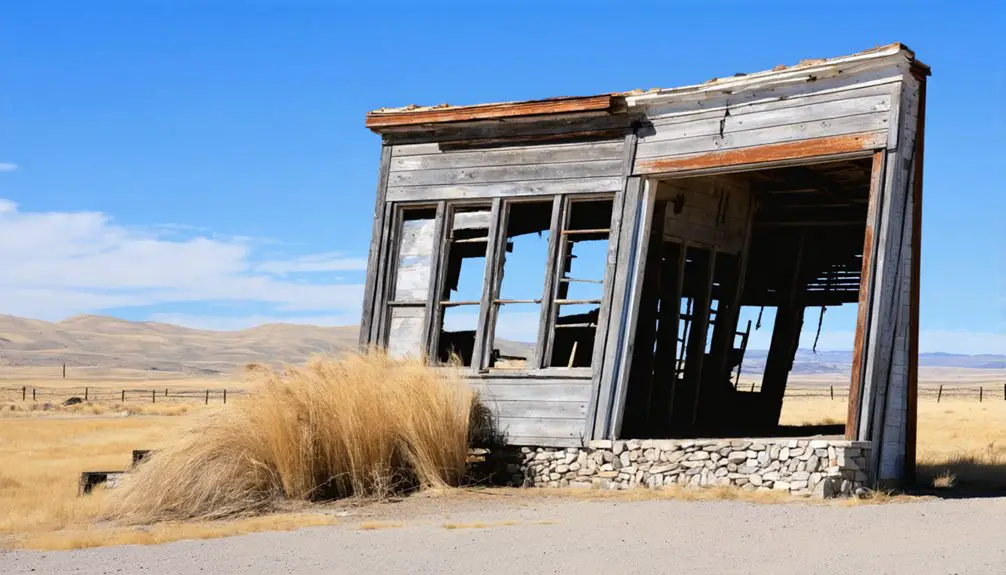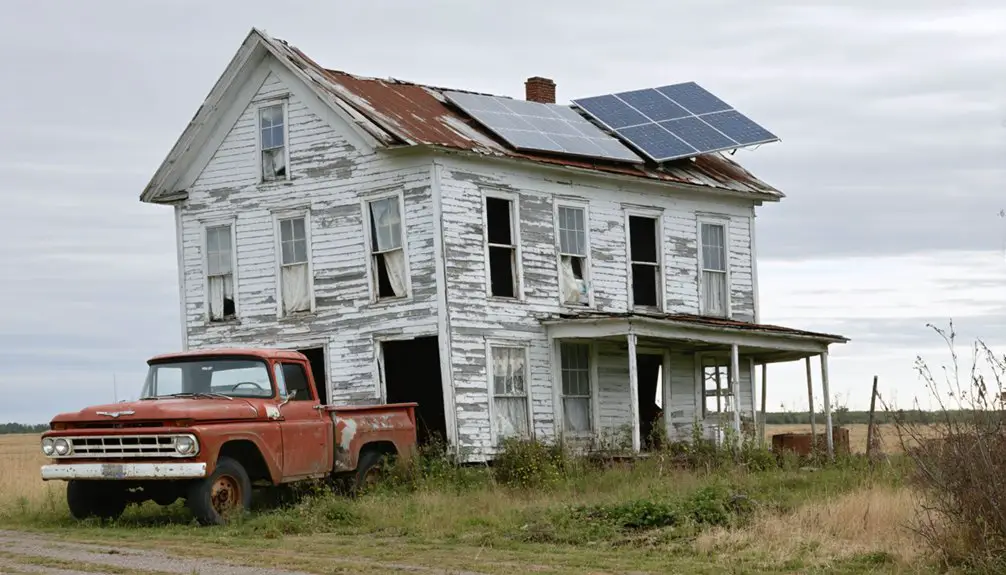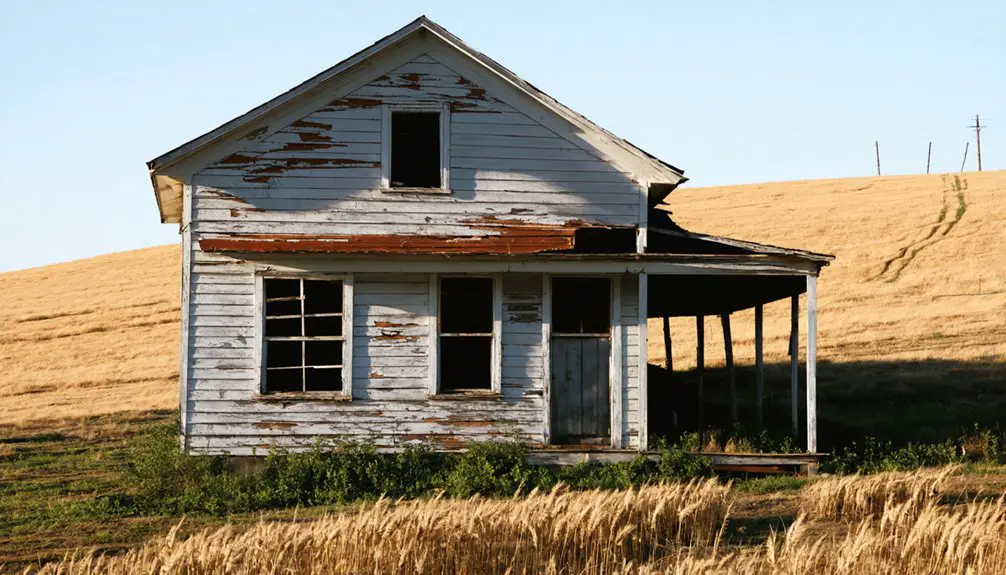You’ll discover Curlew nestled along the Kettle River in Ferry County, Washington, where a once-bustling 1896 mining settlement now stands frozen in time. The town flourished during the gold rush era, complete with rival railroads and a vibrant community of miners, traders, and Native Americans. Today, historic structures like the Ansorge Hotel and the 1901 bridge remain as silent witnesses, while preservation efforts keep the rich stories of this American frontier town alive.
Key Takeaways
- Curlew transformed from a bustling 1896 mining settlement into a ghost town following the collapse of local mining operations and railroad abandonment.
- The town’s decline accelerated after 1935 when the Great Northern Railway abandoned its tracks, severely impacting local transportation and commerce.
- Historic structures like the Ansorge Hotel and 1901 bridge remain standing, serving as preserved remnants of Curlew’s prosperous mining-era past.
- Curlew faces ongoing population decline and vacant buildings, though local societies actively work to preserve its rich cultural heritage sites.
- The former mining community originated during the 1896 gold rush but now primarily exists as a historic site along the Kettle River.
From Frontier Dreams to Settlement Reality
While frontier aspirations often led to short-lived boomtowns, Curlew’s transformation from a mining camp to an established settlement tells a more nuanced story.
You’ll find the roots of this economic evolution in the late 1890s, when adventurers first glimpsed the potential of this strategic location along the Kettle River.
The establishment of a general store in 1896 marked the beginning of Curlew’s development, serving as a vital hub for the diverse community of miners, railroad workers, traders, and Native Americans.
Like other settlements in Okanogan Country that evolved from ranching outposts, the town demonstrated remarkable adaptability in its transition to mining activities.
The Birth of a Mining Town
You’ll discover Curlew’s origins as a mining settlement in 1896, when prospectors rushed to stake claims following the opening of the northern half of the Colville Indian Reservation.
The discovery of rich mineral deposits, including gold, silver, copper, and lead in the surrounding Curlew Valley, transformed this frontier outpost into a bustling mining hub. Like the nearby town of Republic, Curlew experienced a dramatic population surge during the mining boom era. Small towns rapidly formed near productive mining sites as prospectors sought their fortunes.
Railroad workers soon joined the miners, as the Great Northern Railway established critical transportation links that would sustain Curlew’s early growth and development.
Early Mining Community Roots
When the north half of the Colville Reservation was eliminated in July 1892, it triggered a transformative chain of events that would birth the mining town of Curlew. The federal government’s decision, driven by the discovery of gold and a desire for economic development, opened the floodgates for a remarkable gold rush by 1896.
You’d have found pioneering prospectors like John Welty, Tom Ryan, and Phil Creaser braving harsh winters below -20°F to stake their claims near Eureka Creek. Their determination paid off – the region’s rich deposits yielded over 2 million pounds of copper, 6,500 ounces of gold, and 20,500 ounces of silver. Similar to the nearby Stonerose Interpretive Center, the area became a significant destination for scientific research and exploration.
Despite the prospecting challenges, a vibrant community emerged around these claims, transforming from a simple mining camp into a bustling trade center with essential services and infrastructure. Following the pattern of nearby Republic, the area saw its first business established when W.C. Otto’s store opened in a canvas tent.
Railroad Workers Spark Growth
In the bustling early days of 1901, two rival railroads launched an ambitious race to connect Republic’s gold mines with regional markets.
The railroad expansion brought waves of workers who established settlements along the challenging mountain routes, transforming Curlew into a bustling hub of activity.
You’ll find these vivid scenes from the era:
- Railroad crews blasting through mountainsides and constructing massive trestle bridges
- Tent cities sprouting up as worker settlements grew into permanent communities
- Parallel tracks being laid side-by-side as rival companies raced for dominance
- Supply wagons and merchants rushing to serve the growing population
This competitive push to reach Republic’s gold mines sparked rapid growth in Curlew, as workers and their families established homes, businesses, and community infrastructure that would shape the town’s future. The Crow, Flathead Commission ruling on tribal allotments forced one railroad to alter its planned route while allowing the other to proceed. Like the Great Northern Railway years earlier, these rail companies recognized the strategic importance of establishing efficient transportation routes through the Pacific Northwest.
Railroad Whispers and Golden Promises
You’ll find the relics of two ambitious railroads that once raced to reach Republic’s gold fields in 1901-1902: the Washington and Great Northern and the aptly nicknamed “Hot Air Line” – the Republic and Kettle River Railroad.
While both lines laid parallel tracks and promised prosperity, the Hot Air Line‘s grand visions crumbled into bankruptcy by 1919, leaving only the Great Northern to serve the region’s diminishing mining operations.
The railroad dreams that once fueled Curlew’s growth would ultimately fade, as even the Great Northern abandoned its tracks by 1935, marking the slow shift of this once-bustling mining hub toward ghost town status. Like the fate of the Slender-billed curlew last seen in 1995, the town’s vitality gradually disappeared into history.
Railroad Dreams Unrealized
During the early 1900s, two ambitious railroad companies raced to connect Curlew with the region’s bustling gold fields, launching a competitive struggle that would ultimately end in failure.
Railroad ambitions soared as the Washington and Great Northern Railway competed against the Republic and Kettle River Railway, nicknamed the “Hot Air Line” for its grandiose promises.
Financial instability soon derailed these dreams, leading to bankruptcy and abandoned tracks.
- Parallel tracks snaked along opposite valley sides, crossing paths like iron rivals
- Steam engines thundered through remote valleys, carrying precious ore
- Empty train stations stood silent as services dwindled by 1919
- Rusty rails surrendered to nature as companies ceased operations
Mining Legends Live On
While railroad dreams faded into rust, the mining legends of Ferry County burned bright through the stories of determined prospectors and ambitious industrialists.
You’ll find tales of legendary prospectors like John Welty and Patrick “Patsy” Clark, who braved subzero temperatures to stake their claims after the Colville Indian Reservation opened in 1896.
Mining technology evolved from simple picks and shovels to sophisticated chemical milling processes, transforming how gold was extracted from the region’s rich quartz veins.
The Knob Hill Mine stands as evidence to this progress, yielding an astounding 2.4 million ounces of gold.
Through operations like the Republic Mine, Quilp, and Black Trail, these pioneers built an empire of mineral wealth that defined Ferry County’s golden age, turning remote wilderness into bustling mining camps overnight.
The area’s development attracted around 2,000 residents to Republic during its peak, creating a thriving community with multiple hotels and businesses.
Life Along the Kettle River
The waters of the Kettle River shaped the lives of countless Indigenous peoples for millennia, with Kettle Falls serving as the region’s bustling epicenter.
You’ll find the rich history of Indigenous fishing woven into every bend of the river, where up to 2,000 fishers would gather during salmon runs. The cultural significance of these waters extended far beyond sustenance, creating a vibrant hub of trade and ceremony.
- Skilled fishers wielding basket nets and spears could catch 900 salmon daily
- Evening camps came alive with traditional songs and dances
- Tribes traded buffalo robes and horses for precious salmon
- Ancient fishing techniques passed down through generations sustained communities
This thriving ecosystem tragically ended in 1940 when the Grand Coulee Dam‘s waters submerged these sacred grounds.
Architectural Remnants and Historical Landmarks

Standing proudly along the old Great Northern Railway line, Curlew’s architectural heritage offers a compelling glimpse into its prosperous past.
You’ll find the Ansorge Hotel, listed on the National Register of Historic Places since 1979, showcasing its architectural significance with original furnishings and knotted rope fire escapes at second-floor windows.
Throughout town, you can trace the original layout through surviving stone foundations and early 20th-century homes.
The 1901 one-lane bridge across the Kettle River stands as a symbol of historical preservation, while remnants of railway platforms remind you of Curlew’s days as a bustling transportation hub.
The town’s civic landmarks, including the Curlew School building and Chief Tonasket Store, provide tangible connections to the educational, cultural, and Indigenous heritage of this once-thriving community.
The Ansorge Hotel Legacy
Built in 1907 by pioneer William Ansorge, Curlew’s crown jewel hotel emerged as a sophisticated replacement for its more modest predecessor.
The Ansorge Hotel’s historical significance extends beyond its elegant architecture, as it served as a crucial hub during the region’s railroad boom, hosting travelers and workers alike.
A bustling beacon of hospitality, the Ansorge Hotel welcomed both weary rail workers and distinguished travelers during the region’s transformative railroad era.
You’ll find these enchanting historical features preserved within:
- Wood-frame structure with tin siding crafted to mimic stone
- Nine upstairs bedrooms featuring knotted rope fire escapes
- Original furnishings, including a nickel-in-the-slot phonograph
- Distinctive corner window bays and period-authentic balcony
Today, you can explore this National Historic Place as a museum, where the Kettle River History Club maintains the hotel’s authentic early 1900s atmosphere through appointment-only tours from May to September.
Modern Day Ghost Town Living

Modern-day Curlew faces significant demographic and economic challenges that mirror many American ghost towns.
You’ll find a community grappling with population decline as younger residents move away for better opportunities, leaving behind an aging demographic that’s struggling to maintain local services.
Like other rural communities seeking ghost town adaptations, Curlew’s residents have turned to grassroots efforts to preserve their cultural heritage.
You can witness this through volunteer-managed historic sites and community landmarks.
The town’s rural sustainability depends heavily on diversifying beyond its traditional economic base, though limited resources make this challenging.
Without significant infrastructure investments or policy support, you’ll see the familiar pattern of declining property values and vacant buildings that characterize many modern ghost towns, while nearby urban centers continue to grow.
Preserving Stories of the American West
As the preservation of Curlew’s frontier heritage unfolds, you’ll discover a rich tapestry of stories spanning over 9,000 years of human history in Ferry County.
Through carefully documented oral histories and archaeological findings, you’re connecting with the spirits of miners, traders, and indigenous peoples who shaped this rugged landscape.
Step into the echoes of those who came before, as stories and artifacts reveal the untold chapters of this frontier land.
- Ancient camp sites along riverbanks reveal tools and artifacts from Native American settlements
- Weather-worn mining cabins stand as silent witnesses to the gold rush era
- Original schoolhouse foundations tell tales of frontier education
- Trading post remnants mark the crossroads of commerce and cultural exchange
Local historical societies work tirelessly to preserve these cultural heritage sites, ensuring your freedom to explore and experience authentic pieces of the American West through photographs, documented stories, and preserved structures.
Frequently Asked Questions
Are There Any Paranormal Activities Reported in Curlew’s Historic Buildings?
With 98% of reports centered at Job Corps, you’ll find ghost sightings throughout Curlew’s haunted locations, especially in former asylum buildings where shadow figures and unexplained lights frequently appear.
What Happened to the Original Native American Inhabitants of the Curlew Area?
You’ll find the area’s Native American history centers on tribes being forced onto the Colville Reservation in 1872, causing massive cultural impact through displacement from their traditional lands and waterways.
How Severe Were Winters in Early Curlew, and How Did Settlers Cope?
You’d have faced brutal winters with deep snow and freezing temperatures. Settlers’ adaptations included stockpiling food, using wood heat, adopting Native American winter survival techniques, and maintaining essential transportation routes through community cooperation.
What Wildlife Species Are Commonly Found Around Curlew Today?
You’ll spot diverse wildlife around the area, from moose and cougars to rare mollusks like the California floater mussel. There’s excellent birdwatching opportunities, and wildlife conservation efforts protect several endangered species.
Did Any Famous Outlaws or Historical Figures Ever Pass Through Curlew?
Like a ghost story without its ghost, you won’t find evidence of famous outlaws or historical figures in Curlew’s past. Historical records show it was mainly populated by miners and railroad workers.
References
- https://ferrycounty.com/curlew-washington/
- https://okanogancountry.com/ghost-towns
- https://en.wikipedia.org/wiki/Ansorge_Hotel
- https://www.ghosttowns.com/states/wa/curlew.html
- https://www.pinterest.com/pin/360569513892762464/
- https://en.wikipedia.org/wiki/Curlew
- https://ferrycountyhs.org/a-history-of-ferry-county/
- https://en.wikipedia.org/wiki/Ghost_town
- https://parks.wa.gov/about/news-center/field-guide-blog/curlew-lake-state-park-history
- https://ferrycountyhs.org/a-mining-history/



